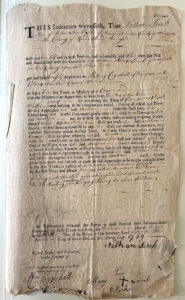Hampton Smith, Ph.D. student, MIT, is one of the 2021 Buchanan Burnham Fellows working on capturing data from the NHS archives on Black and Indigenous people of color in colonial Newport, Rhode Island. The following post relates to the bond and indenture documents Hampton is currently studying.
The word ‘Bond’ often connotes restraint: as in to be forcibly, and sometimes violently, bound by or to something. But the word itself refers to numerous methods of relating people, places, and things. Whether a binding

The top portion of an indenture agreement showing the indented cut used to authenticate the document. Box 55, Folder 12, NHS Collection.
agreement to a spouse, sworn oaths of allegiance, atomic bonds, or the affective ties of friendship—our lives are intricately composed of many types of bonds. They connect and bind us together, forging our shared history into an interlocking web.
In the archive of the Newport Historical Society, bonds most regularly surface as legal indenture documents. The term indenture originates from the materiality of a broad category of early modern paperwork. As forgery of these highly important documents was popular, duplicate contracts were copied on the same sheet of parchment, and, later, paper. These two, identical copies were cleverly separated by a jagged or toothed cut: an indentation (hence the word indenture!). The indented cut made it easy to retrofit the two documents

A standard indenture agreement, showing the terms of the indenture, the signatures of the involved parties and witnesses, and an official seal. Box 55, Folder 11, NHS Collection.
back together, thereby confirming authenticity and preventing forgeries.
While only some of Newport’s bond agreements have this decorative flourish, most agreements have a standardized manner of communicating information. Indeed, these are formulaic documents with easy-to-fill-in blanks. Each contract begins with the names, place of residence, and occupations of the bound parties. The terms of the contract are then elucidated, followed by the date in which the bond is to take effect. A conditional agreement, to ensure the bond is completed in a timely and fair manner, is sometimes written below. The signature and seal of the involved parties as well as at least two signatures of witnesses grace the bottom of each document.
At first, these documents might appear to be the detritus of a past bureaucracy. Paperwork is, after all, so often the bane of efficiency. Need I remind you of how many times paperwork has exerted too much control over the pace of life? And yet, for today’s researchers, bond documents offer more than just a paper trail. If we interpret bond documents as containing many relationships—instead of just one initial agreement—this paperwork moves beyond the banal to illustrate the social lives of real estate investors and slave owners, speculators and blacksmiths, cunning widows and official witnesses alike.
This summer, as a fellow for the Newport Historical Society, I am recasting the information nestled in the standardized blanks of bond agreements to add to a forthcoming database. Because each individual filled out the exact same paperwork, we are able to recast portions of how individuals were bound within their society. Bond documents establish who owned land, who borrowed and who sold their property, who worked for whom, who crafted relationships, who had power and who did not. They narrate the colonization, speculation, and development of land. They tell us how individuals were involved in the slave trade and how money moved across time and space. And while some illustrate historic actants in a consistent state of debt, others indicate an earnest desire to improve life through apprenticeship. By retrofitting the information held within these filled blanks, we hope to illustrate how Newport became bound together.